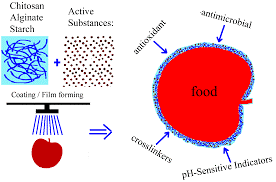
Uses of Polymers in Encapsulation
Encapsulation is defined as the technology of packaging solids, liquids or gaseous materials in matrices (encapsulants) that can sustain and possibly release their contents under specific conditions. Encapsulation can have multiple purposes, the first of which is to protect sensitive components from light, moisture, or heat. Second, encapsulation can be used for improving the stability of biological pigments as a dispersion in aqueous systems to increase the usability of natural colorants in many industrial applications. Another advantage of using encapsulated products is that their protective shell stays intact and therefore the colorants do not easily migrate through the product as conventional colorants do. The brightness of the colorants can also be improved, thus increasing their marketability for commercial use.

Source: MDPI.com
Encapsulation offers improved stability for the often sensitive natural colorants by creating a barrier. An additional benefit of this is that possible off-flavours of the colorants can be masked by the biopolymer. Also, stability can be further improved by adding antioxidants and other stabilisers to the particles. Using encapsulation for the delivery of colorants presents the possibility of entrapping water-insoluble colorants and using them in an aqueous system, which broadens the number of natural colorants that can be easily used in food product development systems.





